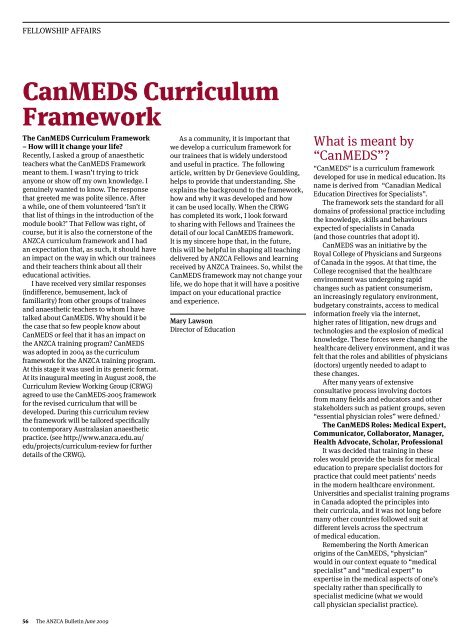ANZCA Bulletin - June 2009 - Australian and New Zealand College ...
ANZCA Bulletin - June 2009 - Australian and New Zealand College ...
ANZCA Bulletin - June 2009 - Australian and New Zealand College ...
- No tags were found...
Create successful ePaper yourself
Turn your PDF publications into a flip-book with our unique Google optimized e-Paper software.
fellowship affairsCanMEDS CurriculumFrameworkThe CanMEDS Curriculum Framework– How will it change your life?Recently, I asked a group of anaestheticteachers what the CanMEDS Frameworkmeant to them. I wasn’t trying to trickanyone or show off my own knowledge. Igenuinely wanted to know. The responsethat greeted me was polite silence. Aftera while, one of them volunteered ‘Isn’t itthat list of things in the introduction of themodule book?’ That Fellow was right, ofcourse, but it is also the cornerstone of the<strong>ANZCA</strong> curriculum framework <strong>and</strong> I hadan expectation that, as such, it should havean impact on the way in which our trainees<strong>and</strong> their teachers think about all theireducational activities.I have received very similar responses(indifference, bemusement, lack offamiliarity) from other groups of trainees<strong>and</strong> anaesthetic teachers to whom I havetalked about CanMEDS. Why should it bethe case that so few people know aboutCanMEDS or feel that it has an impact onthe <strong>ANZCA</strong> training program? CanMEDSwas adopted in 2004 as the curriculumframework for the <strong>ANZCA</strong> training program.At this stage it was used in its generic format.At its inaugural meeting in August 2008, theCurriculum Review Working Group (CRWG)agreed to use the CanMEDS-2005 frameworkfor the revised curriculum that will bedeveloped. During this curriculum reviewthe framework will be tailored specificallyto contemporary Australasian anaestheticpractice. (see http://www.anzca.edu.au/edu/projects/curriculum-review for furtherdetails of the CRWG).As a community, it is important thatwe develop a curriculum framework forour trainees that is widely understood<strong>and</strong> useful in practice. The followingarticle, written by Dr Genevieve Goulding,helps to provide that underst<strong>and</strong>ing. Sheexplains the background to the framework,how <strong>and</strong> why it was developed <strong>and</strong> howit can be used locally. When the CRWGhas completed its work, I look forwardto sharing with Fellows <strong>and</strong> Trainees thedetail of our local CanMEDS framework.It is my sincere hope that, in the future,this will be helpful in shaping all teachingdelivered by <strong>ANZCA</strong> Fellows <strong>and</strong> learningreceived by <strong>ANZCA</strong> Trainees. So, whilst theCanMEDS framework may not change yourlife, we do hope that it will have a positiveimpact on your educational practice<strong>and</strong> experience.Mary LawsonDirector of EducationWhat is meant by“CanMEDS”?“CanMEDS” is a curriculum frameworkdeveloped for use in medical education. Itsname is derived from “Canadian MedicalEducation Directives for Specialists”.The framework sets the st<strong>and</strong>ard for alldomains of professional practice includingthe knowledge, skills <strong>and</strong> behavioursexpected of specialists in Canada(<strong>and</strong> those countries that adopt it).CanMEDS was an initiative by theRoyal <strong>College</strong> of Physicians <strong>and</strong> Surgeonsof Canada in the 1990s. At that time, the<strong>College</strong> recognised that the healthcareenvironment was undergoing rapidchanges such as patient consumerism,an increasingly regulatory environment,budgetary constraints, access to medicalinformation freely via the internet,higher rates of litigation, new drugs <strong>and</strong>technologies <strong>and</strong> the explosion of medicalknowledge. These forces were changing thehealthcare delivery environment, <strong>and</strong> it wasfelt that the roles <strong>and</strong> abilities of physicians(doctors) urgently needed to adapt tothese changes.After many years of extensiveconsultative process involving doctorsfrom many fields <strong>and</strong> educators <strong>and</strong> otherstakeholders such as patient groups, seven“essential physician roles” were defined. 1The CanMEDS Roles: Medical Expert,Communicator, Collaborator, Manager,Health Advocate, Scholar, ProfessionalIt was decided that training in theseroles would provide the basis for medicaleducation to prepare specialist doctors forpractice that could meet patients’ needsin the modern healthcare environment.Universities <strong>and</strong> specialist training programsin Canada adopted the principles intotheir curricula, <strong>and</strong> it was not long beforemany other countries followed suit atdifferent levels across the spectrumof medical education.Remembering the North Americanorigins of the CanMEDS, “physician”would in our context equate to “medicalspecialist” <strong>and</strong> “medical expert” toexpertise in the medical aspects of one’sspecialty rather than specifically tospecialist medicine (what we wouldcall physician specialist practice).56The <strong>ANZCA</strong> <strong>Bulletin</strong> <strong>June</strong> <strong>2009</strong>
















